"Zhvanets to Prague" - a trip into history
By
Related to: Zhvanets (Town),
|
In May of 2004 I decided to go on a guided tour of Eastern Europe that began in Warsaw, continued on to Krakow, Budapest, Vienna and Prague. I visited the Jewish quarters in all of these exciting and amazing cities and also spent a day at Auschwitz and Birkenau.
In the initial stages of planning I realized just how close I was to Ukraine and arranged a private tour to visit ‘my’ shtetl of Zhvanets. I want to share with you, my dear family and friends my journey to my past.
|
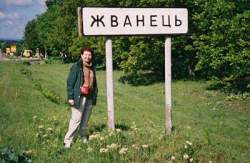
|
I flew from Warsaw, to the city of Lviv1 in Ukraine in a two propeller, thirty passenger LOT2 airplane. The 1000 mile flight was short. It took only an hour and a half, but in that hour and a half I was to enter the 19th century. In Lviv every modern amenity is available to the sophisticated traveler , but when I left the city and drove into the country the world as I know it would change dramatically.
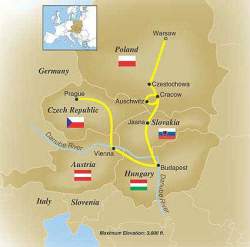
|
I had sent my photo to Alex Dunai who met me at the airport. He is a large, happy man with a big smile who greeted me with a bear hug as if I were a long lost relative. We visited for a short time and he left on business for Krakow, Poland. Alex had organized my tour and arrived with my guide Svitlana Kovalyk and my driver Bogdan Melnik, who drove a four-door older model Mercedes. Svitlana is fluent in five languages and teaches both standard and business English as well as literature. Bogdan spoke only Ukrainian. I do not know one word in Ukrainian and I still don’t. My tongue and the Slavic languages have not yet become acquainted.
|
When we left the airport I suggested that we have a restroom stop before starting the trip. This was my first reality check. As in most restrooms in Europe there is an attendant who must be paid before paper is handed out. However, the facilities were Asian style, that is, a hole in the floor but with separate stalls.
So I began my journey to Zhvanets, "my" village, my shtetl, where my great grandfather Hanech Shapiro and all ten of my great uncles and aunts were born. My grandmother, Bube Rifka Shapiro Taylor was married in Zhvanets. The village is so small that it is not even on a current map. When I visited the Library of Congress in Washington, DC, in the summer of 2003, to attend the 23rd international Jewish Genealogy conference, I found a map from 1876 that shows Zhvanets and the surrounding areas. Although the actual driving distance was short by North American standards, only 300 kilometers (186 miles), the drive to Kamianets-Podilskyi on a two lane road took five and a half hours. The trees lining the highway reminded me of drives in the countryside almost anywhere in the world. Except here I saw a few people on the road in their horse drawn carts.
The day was cool. I did not see one gas station en route. Bogdan’s radio was tuned to a jazz station that I didn’t mind at all. He is also a musician and plays with a band. We would have dinner in Kamianets-Podilskyi3 at the Hotel Xenia, where we would be staying for two nights. Remember camping trips? Well when the need arose, it was ladies to the right, Bogdan to the left. Little did I realize when I started researching the Shapiro/Taylor family tree four years ago, by scribbling a few names on a napkin at cousin Sybil Howard’s home in LA, that I would actually make a trip to my ancestral village! My only thought at that time was just to get a ‘little something’ jotted down for my wonderful grandchildren, Sydney and Adrian Freedman.
As we drove, we passed many small villages. We saw almost no cars on the road. The homes are set back about 15 to 20 feet from the road and are fenced. On the road side of the fence, benches and chairs are placed where the neighbors come out to sit, chat and gossip. Cows graze in the grassy area between the fence and the road unless a larger area is nearby. We passed elderly men and women tending the family cows as they grazed along the highway. All the women I saw wore scarves, babushkas, tied around their heads. I saw countless people of all ages working in their gardens or on larger plots of land behind their homes. This wasn’t just a pastoral scene from the 19th Century. This was survival. 29% of the 47 million people in the Ukraine live below the poverty line. Every family in rural areas has a cow, chickens and a plot of land. What is grown is vital to their daily needs. Potatoes are a staple.
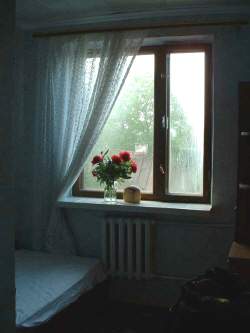
|
As we drove up to the hotel I was pleased to see that the Hotel Xenia looked quite presentable. Alex had assured me that the hotel was clean and there were no bugs! The advance payment of $40 per night included breakfast. The hotel was like a stage set. From the outside it looked great, but inside was another matter, not that I was expecting a Sheraton. There was a maze of stairs leading to unfinished floors and sections of the hotel. They had probably run out of money and stopped and started construction many times over the years.
|
I awoke the next morning after a good night’s sleep in a very cold room despite wearing four layers of clothing, my coat and an eye shade. I was a sight to behold! The weather was quite cool and the old fashioned radiator in my room, even turned on at its highest only raised the room temperature to about 17 degrees Celsius. After a certain time of the year the heat is turned off, no matter the weather. The only window covering was a sheer lace curtain through which I watched and heard the neighbour’s chickens strutting in the garden.
Breakfast included potato pancakes, latkes, prepared the way my grandmother used to make them. Not the crispy latkes that most of us now make, but more like small oval pancakes, very light and sprinkled with sugar. The food was very good and all the tastes were familiar. A dinner of meatball soup and a main course of verenikas was Cdn $3.75. An excellent bowl of borsht was 35 cents. It was really cold in the dining room too and I ate all my meals with my coat on.The dining room area was divided into two parts, one was a large high-ceiling space where parties were held and another cozier section which included four enclosed booths – similar to a Japanese restaurant only with Ukrainian cross-stitched red and blue embroidery on the curtains. Before checking out of a hotel in the Ukraine, the room is checked to make sure nothing is taken, even in the fancier hotel in Lviv. Believe me, there was nothing to take from the Xenia Hotel. Only one very thin towel was supplied – that’s it.
You can imagine my excitement when we finally got into the car that morning. In fifteen minutes I would actually be in Zhvanets! To put things into some perspective here are a few statistics. In 1847 during the Czarist regime, the Jewish population in Zhvanets numbered 1619 people and according to the 1897 census, among the general populace of 5005 there were 3,353 Jews or 67% of the population. I did not expect to find any living relatives there as the Shapiro and Taylor families left between 1904 and 1912. In 1941 the Jewish population was totally annihilated in Zhvanets and environs.
We arrived in Zhvanets quickly. Bogdan parked the car near the city hall and Svitlana went in to find the Mayor. She knew I wanted to see the Jewish cemetery and drive around the former Jewish area. He was away in Kamianets-Podilskyi that morning but Svitlana spoke to Anna Viktorivna Spivak, the assistant mayor, who phoned someone to come and give me a tour. What a surprise when Petro Bratvanovych, a sprightly ninety-two year old former deputy principal, teacher and historian joined us. Svitlana, Anna, Petro, Bogdan and I crowded into the car and drove the very short distance to the Jewish area.
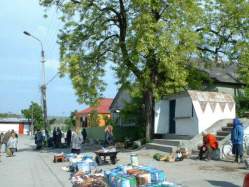
|
We then went to the Jewish area near the market place. Petro pointed to a couple of homes and said that was ‘Guttmann’s house’ and that is where "Seltzer" stored his wares. We saw the site of one of the original synagogues, part of which is now occupied by a bakery the other an empty, graveled overgrown lot. My Bube Rifka may have been married here! Anna went to the bakery and bought me a loaf of warm bread just out of the oven.
|
|
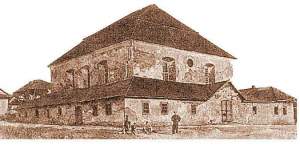
|
|
One of two original synagogues, circa 1800's
|
No one spoke English except for my guide, so all our conversations had to be translated. Anna had some work to do so we returned to the city hall where the Mayor now joined our group and we all continued onto the cemetery. His name is Mykola Borysovych Makovski, or Nick for short.
Footnotes:
1 Lviv had the following names: Lwow, Poland (13th Century to 1772); Lemberg, Austria (1772-1918); Lwow, Poland (1918-1939); Lviv, Ukraine (1939-to present). Lwow is pronounced Lvov or Lvuv.
2 LOT, which means flight in Polish, is the name of the Polish Airline
3 Kamianets-Podilskyi , the Ukrainian spelling, is a district capital and can be found on all maps dating back to the thirteenth century. Spellings changed according to the governing countries language.
I felt like I was in a Tolstoy novel.
We first walked by the Polish section of the cemetery where Nick pointed out his father’s gravesite. Photos of the deceased are put on the stones. We walked into the woods to see the Jewish cemetery1. I felt quite emotional. The stones that I saw were tilted, leaning towards the ground, but did not appear to be broken. I scraped many layers of moss off one of the stones and had I had the time to clean it up, the writing would have been legible. It is in a heavily wooded area. There had been a recent rainfall and my brand new Nike running shoes were covered in mud. The first time in my life I actually dirtied a pair of running shoes!
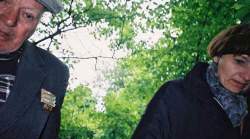
|
We stopped at different points around the village and met some of Petro’s former students. One was an eight-three year old lady who remembered lighting candles on the Sabbath for a Jewish family. A broad smile revealed her one remaining shiny, gold tooth, Another elderly student proudly said that she spoke English, but we were not really able to converse. |
|
Petro Bratvanovych and Svitlana Kovalyk
|
We returned to City Hall, where Anna surprised me with a beautiful bouquet of large, burgundy peones and irises from her garden. She invited me to come and stay with her. They were very kind and probably both fascinated and a little perplexed that a North American would have such an interest in their village.There is no indoor plumbing in the village, as is the case in most small towns and villages throughout rural Ukraine. The only difference between the outhouse for the City Hall and others that I saw was that it was made of brick and was a doorless two-seater.
The village had telephones, but not one computer. Out of a total population of 1650 people, eighty-five women from the village live and work in Italy to send home money to supplement their family's income, very much like the Philippine community. The average annual income for a doctor or a teacher in the Ukraine is approximately six hundred US dollars a year. The mayor earns 273 UAH2 a month. There is no work in the village.
Svitlana took some photos of the Mayor and I and he and Anna walked me to the car and waved goodbye. Petro kissed my hand with old world gallantry. It was in order for me to offer him something for his tour, which I did. At first he did not want to take anything, but I asked Svitlana to tell him that it had been an honour for me to meet someone who had been one of the many liberators of Auschwitz. He smiled with great pride when she translated this for me.
The next morning I decided to return to Zhvanets to have a quiet, more reflective look at the shtetl. What good luck. It was market day and we arrived at the square just in time to see that over a period of a hundred years nothing had changed. People were selling and people were buying. When you look at the photos, just imagine you’re seeing horse drawn carts instead of cars. There was a hatchback station wagon with the back open displaying a pile of freshly baked breads and round loaves that looked like challahs. Many people were selling shoes which of course interested me. They were displayed on blankets on the ground and on the hoods of cars. My Bube Rifka had gone to Kamianets-Podilskyi to have her wedding shoes repaired.
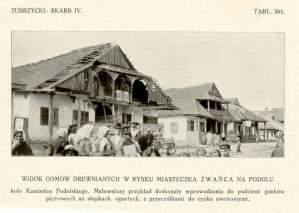
|
I can see in my mind’s eye what the village square would have been like in the 1800’s. I can hear the haggling over a loaf of bread or a piece of fish for Shabbat. I am thrilled that even with not a little trepidation I decided to embark on my small journey. It was small in terms of distance and time but will loom forever large in my memory. I had the privilege and opportunity to briefly glimpse the life that my Great Grandfather, great Uncles and Aunts and my Bube and Zade lived. |
I saw for myself part of the landscape that made up the Pale of Settlement where almost five million Jews once lived. I bless my family for their courage. Courage beyond anything I can comprehend in leaving a small dot on a map in the Ukraine to journey across the ocean. They had no money and no knowledge of the English language. They were no longer able to endure the hardships, the poverty and the pogroms. They endured conditions on the ships that we can’t even imagine.And so they arrived.
What a forever special trip it was for me. It gave me a sense of continuity and identity and fills me with great emotion. Zhvanets in Ukrainian means bell. Perhaps the sound of the tolling bell of the Zhvanets from which we came can still be heard and felt today just a little in all 560 descendents of Hanech Shapiro who are currently named in our family tree.
Had they not left, I would not be here to tell their story.
APPENDIX
1 Cemetery - Currently plans are underway for ‘Zhvanetsers’ to restore and maintain the cemetery that contains about 1200 stones. I am certain that some of our relatives rest there.
2 The currency is called hrynya (h-ren-ya) and is written UAH. 1 US dollar is equal to 5.33 UAH (Feb 2007).
Photos of market place and synagogue courtesy of Dr. Rand Fishbein, a fellow Zhvanetser. Reference: Kaminits-Podolsk & Its Environs /Bonnie Schooler Sohn/Avotaynu Foundation Inc.
Map of Ukraine
|
|
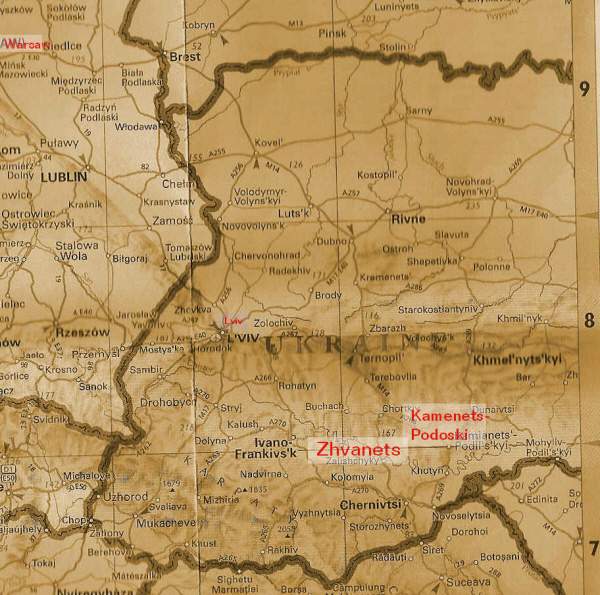
|